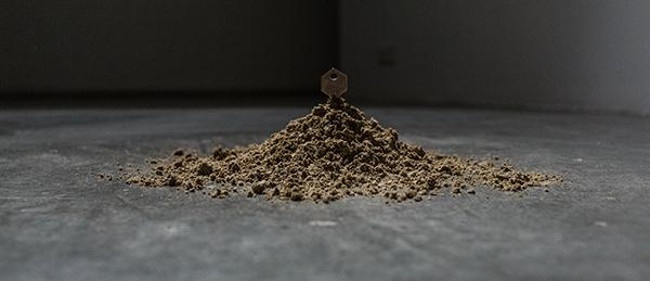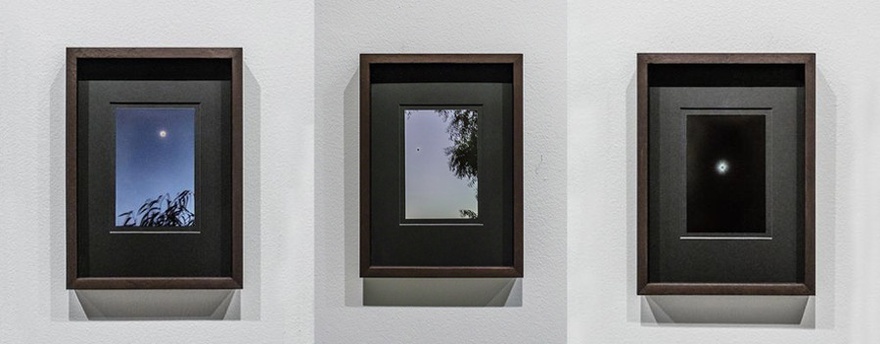Reviews
Stéphanie Saadé
Grey Noise Gallery
In 1960, Piero Manzoni blew up a red balloon, tied it to a piece of string, and affixed it to a wooden base. Over time, the balloon shrank and congealed into a rubbery puddle. Fiato d'artista (1960), a small bronze plaque read: the breath of the artist that gave the balloon both form and failure. In Stéphanie Saadé's The Shape of Distance (2016), the balloon is white, and filled with the breath of not just Saadé but also her lover and fellow artist, Charbel-Joseph H.Boutros. It is the second iteration of the homage, pluralized here as Souffles d'Artistes (2016) – a visitor accidentally popped the first but, anticipating such an event, the couple had already made a backup. Positioned on the polished concrete floor, the balloon carries a quiet intimation of sympathetic magic. Perhaps Saadé and Boutros had a fight back in Beirut at the moment of rupture; perhaps it didn't affect them at all.
There's a shy sweetness running through the exhibition, like a lightly syruped sponge cake. It takes a slightly naff gesture like the balloon, already saggy in its slow deflation, and makes it somehow improbably charming. Like a pair of small hands placed on the eyes from behind, it covers a childhood photograph in gold leaf to obscure Saadé's early experiences of the Lebanese Civil War and instead leave behind the Golden Memories (2015) of the title. 'The past memory is no longer accessible, but now mirrors the present reality', she explains in a series of spare one liners accompanying the show. Yet if the Beirut of her past is now piled high with municipal refuse and the detritus of the civil war, we see none of that here. When you enter the gallery, the key to her childhood home – Artificial Nostalgia (2014) – is stuck, irretrievable like the sword in the stone, in a pile of sand from Dubai. (It's a recurring work; the sand here is pleasingly chalky, inescapably of the coast, and not from the ruddy dunes further inland or worse, the silty marshes of empire). On another wall a Mercedes symbol-on-CD, the kind a taxi driver might couple with a cedar-scented and shaped tree on their rearview mirror to evade radar recognition, gleams even as it resists casting any rainbows.
In the Moongold (2016) series of photographs, the moon is similarly covered with gold leaf, carefully cut to match its waxing or waning phase. The images are taken at different times of day and night, but the moon is always very, very high in the sky and very, very small. The soft aureoles of moonglow are left untouched, creating a kind of leaky eclipse effect. These tiny foiled crescents and gibbouses are echoed in Moon Pills (2015), in which a full lunar cycle has been painted onto a month's worth of contraceptive pills, neatly arranged on a low nightstand. At risk of upholding tired binaries, perhaps it's these pills that lock in the show's curiously feminized air-taken all together, the show engenders the same feeling you might get when you read an Elena Ferrante or Colette novel. Or that scene from Breakfast At Tiffany's where Audrey Hepburn perches daintily on her windowsill and sings Moon River (in such elegantly studied unconsciousness) into the night. Saadé's notes and Chiara Ianselli's exhibition text certainly contribute to this feeling, with a tone that is part k-mart realism, part jeune-fille sad girl on the internet, yet also shot through with a gossamer thread of optimism, much like the show as a whole.
And then there's the jasmine, dried and scattered in one gallery corner-and in many a Beiruti home-in Re-Enactment LB/Jasmine (2016), or more ephemerally, the perfume worn by the artist for the duration of the exhibition in The Smell of Distance (2016). 'A triangle of fallen stars,' she calls it, referring to jasmine's five-pointed petals, yet the flowers emit no scent. In Down to Earth (2016), Saadé similarly searches for her birthdate in a trio of drop-down menus shown at ten-year intervals; by the third, she's too old and the date doesn't appear anymore. Still, the works look to close this distance between earth and sky, between past and present, between even the individual works in this very minimal show-and to measure it in The Day in Order (2015), an acrylic ruler painted with a sky.
In the trimetallic Graceful Degradation (2013), a welded ladder of iron, stainless steel and brass gestures at ascension as it reaches towards the sky. It is mirrored in the titular The Shape of Distance (2016), in which brass extensions are welded onto an ordinary schoolroom chair and table, to raise them to the height of a professor's in a beautiful encapsulation of wanting to be just a little bit taller, a little bit older. And finally, there's The Sky is a Village (2016), the sky of her childhood and outside her studio windows: blown up and left to the ravages of sun and rain, drying into frilled edges, dogeared and marked as meaningful, but not really.







